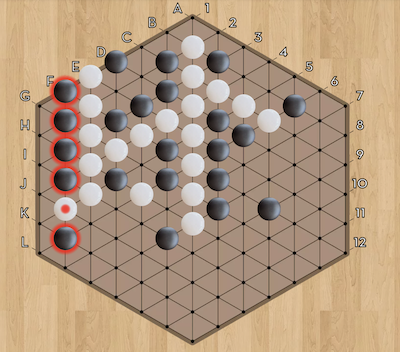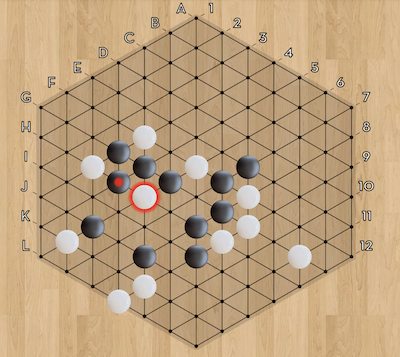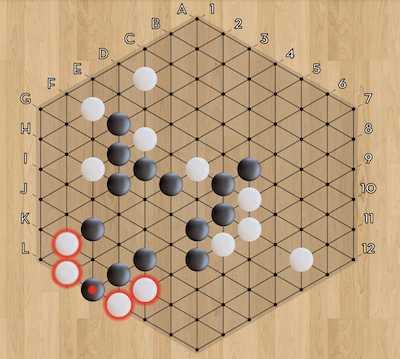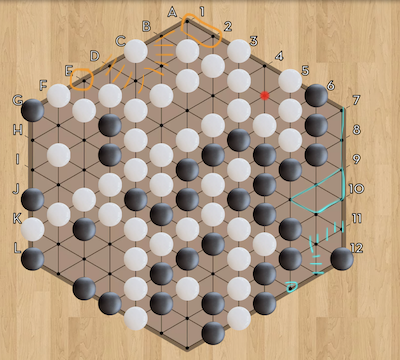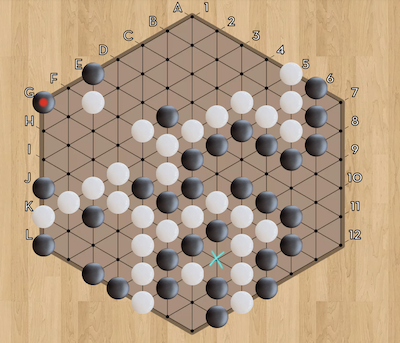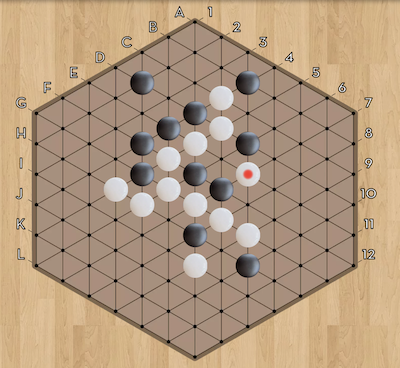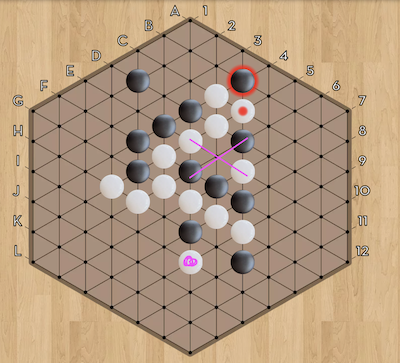This is a documentation for Board Game Arena: play board games online !
Tips meridians: Difference between revisions
(→Tempo: -> adding in ideas to sacrifice pieces.) |
Rednasflor (talk | contribs) (→Tempo) |
||
| (2 intermediate revisions by the same user not shown) | |||
| Line 40: | Line 40: | ||
[[File:Meridians_territory.png]] | [[File:Meridians_territory.png]] | ||
In the upper | In the upper left area in the above example, rather than having a stone on the corner of the board, white has a stone on the side, and so needs to reserve the neighbouring 4 spaces in order to not have their group be captured (assuming all other territories are to be filled in completely). So even though there is 7 empty spaces in this orange area, White will only fill in three of these spots, excluding the four dashed ones. | ||
==== Efficiency of filling in territory ==== | ==== Efficiency of filling in territory ==== | ||
| Line 91: | Line 91: | ||
In meridians and other games, it's useful to play moves that give you initiative. Sometimes this is called gaining a tempo, or if you have to spend one more move defending, or unnecessarily play a move or defensive move, it can be seen as losing a tempo or giving initiative to the opponent to play where they want to. | In meridians and other games, it's useful to play moves that give you initiative. Sometimes this is called gaining a tempo, or if you have to spend one more move defending, or unnecessarily play a move or defensive move, it can be seen as losing a tempo or giving initiative to the opponent to play where they want to. | ||
In the previous section example, White gave up the initiative when playing a double path move. However when Black next tries to cut this double path, which we said takes moves to do, they end up losing a tempo when white counter cuts like below, as now Black is on the defensive to save one of their stones. | In the previous section example, White gave up the initiative when playing a double path move. However when Black next tries to cut this double path, which we said takes 2 moves to do, they end up losing a tempo when white counter cuts like below, as now Black is on the defensive to save one of their stones. | ||
[[File:Meridians_crosscut.png]] | [[File:Meridians_crosscut.png]] | ||
| Line 99: | Line 99: | ||
The player that can gain an extra path for one of the groups involved in the cross cut will be at an advantage, as they will be able to connect through the cross cut first cutting the opponents groups. In some cases this connecting move gains a tempo putting the opponent on the back foot, taking initiative. | The player that can gain an extra path for one of the groups involved in the cross cut will be at an advantage, as they will be able to connect through the cross cut first cutting the opponents groups. In some cases this connecting move gains a tempo putting the opponent on the back foot, taking initiative. | ||
You can see in the same example above that White's large group is involved in two cross cuts, and even if they could be cut across one, they would still be safe because of the other existing. Black needs to find a way to gain paths for all groups in these cross cuts to have any reasonable chance attack White's main group, and so creating one | You can see in the same example above that White's large group is involved in two cross cuts, and even if they could be cut across one, they would still be safe because of the other existing. Black needs to find a way to gain paths for all groups in these cross cuts to have any reasonable chance to attack White's main group, and so creating one or more of these cross cuts can be a tactic to take and hold initiative, or to outright live as in the case of the seki previously. | ||
One other idea is to sacrifice to gain a tempo. That is, you might not need to save every piece on the board. If you find yourself forced into defending all game, you can try to figure out which stones are important and which ones are not, and then sacrifice some of them to either counter attack or to seal off or break into a larger area. This could include some of the pie stones for instance mentioned in the next section on the pie rule. | One other idea is to sacrifice to gain a tempo. That is, you might not need to save every piece on the board. If you find yourself forced into defending all game, you can try to figure out which stones are important and which ones are not, and then sacrifice some of them to either counter attack or to seal off or break into a larger area. This could include some of the pie stones for instance mentioned in the next section on the pie rule. | ||
=== The Pie rule === | === The Pie rule === | ||
Latest revision as of 13:21, 19 September 2023
Meridians is an annihilation game where you have to capture all of your opponents stones. In some games you will be able to actively capture your opponents pieces, but in others it might be that you have to wait until your opponent captures themselves. Since there is no passing in meridians, the board will continue to fill up, and somebody as a result will lose all of their pieces.
Meridians strategy is still evolving but I'll try to capture some key ideas that should help you to come up with your own strategies for winning games.
Capturing pieces
Since the game is about annihilation, it's important to know how to capture pieces. Stones and groups of stones are alive when they have a straight line path to another separate stone or group. In order to capture the opponents groups you should break these paths by interrupting them with your own pieces.
Now it might seem that even when you interrupt a path the opponent will just place a new stone to create a new path, saving the attacked stones, but this is not always going to be possible. Here's some examples of that below:
In the example above, it showcases two ideas for capturing pieces.
minimum space
The first is that groups need a certain minimum amount of space in order to avoid being captured. You need enough room to be able to fit two stones or two groups separated by a one space gap in order to have a path between them. In this example, Black's pieces were all along the second line (one step away from the edge) which left Black no room to make a path to a new stone.
Here's another example of a stone being captured in the center of the board
double attack
While it's true that the opponent can always try to add another stone to make a path and save attacked stones, this requires that the new stone see both of the attacked stones, that is there are two paths joining to both attacked groups that cross at one intersection, which is where you place the new stone. This won't always be the case, and so the opponent will have to decide to save one group or the other and won't be able to save both.
Here's one more example of that kind of double attack below:
There's no way for White to find a place to play a new stone which has a path to both groups of two stones. So white will have to choose to save one or the other.
Territory and living groups
Since it can be the case that you won't be able to capture all of your opponents groups and you can't pass, it makes sense to be able to reserve spaces to play for yourself which your opponent can't play for later in the game. It makes sense to define territory as moves that can only be played by one colour.
In the example below Black has territory in the bottom right marked blue, while white has some small territories in the top left, one of which is marked in orange. In order to count the sizes of these territories it makes sense to only count moves that a player can play which doesn't capture their group. So for Black, though there is 11 free spaces, at most 8 of them can be played. The dashed three points around the single stone shouldn't be played, in order to play the other 8 moves. This is best Black can do.
In the upper left area in the above example, rather than having a stone on the corner of the board, white has a stone on the side, and so needs to reserve the neighbouring 4 spaces in order to not have their group be captured (assuming all other territories are to be filled in completely). So even though there is 7 empty spaces in this orange area, White will only fill in three of these spots, excluding the four dashed ones.
Efficiency of filling in territory
The most efficient place to play a path stone is in the corner as seen above, since one only needs to reserve three spaces for the groups not to merge and be captured. A path stone on the edge requires four reserved spaces, and a stone in the centre requires all six spaces around it to be reserved, if this is the only path keeping a surrounding group alive.
Living groups
In the previous example of territory, both the Black and White group are alive and cannot be captured by the opponent. They both have a single stone in a territory, meaning the opponent has no legal moves there and so cannot threaten or make any moves to capture the opponents groups.
This is not the only way to make a living group however. Earlier in the game, White surrounded some Black stones, and placed a single path stone in this area, see below. The way for black to capture the single stone and the whole group would involve black playing at the marked X point. However because of the way capturing works in Meridians compared to some other similar games, if Black plays the X, they first remove their own captured stones, before giving the opponent a turn to save any stones with no paths. So Black playing the X, joins their two groups, capturing them, and actually making the area into territory for White instead.
This is kind of a seki, if you're familiar with the term from the board game Go. The X is a point that neither player wishes to play as it is bad for both, and so both the large white group, and the two black groups can live in this area, as long as white does not find another area to create a path in. Both players also still have moves in this area, so it's a shared area, as opposed to a territory for one or the other.
Taking the most points with living groups
Once you have a living group, the best way usually of making points is to create a territory, ideally with a path stone on the corner of the board, but the side is also fine. Having a path stone in a territory means, if you surround any other small areas with opponents groups, you can also capture these. In the previous example White's main group was alive, because neither player wanted to play the X point, but later when White created a territory, White could come back to play moves like the X move, and capture the black stones.
Generally however if you surround multiple areas containing the opponents stones, and you can't create a territory with room for a path stone, you should capture the opponents stones which leave you with the more territory. That is leave the opponents stones alive in the smallest area, and capture all other stones. Each capture-able opponent stone will be like one point of territory when it is removed, so you can use this a guideline for a minimum amount of points in an area.
Efficiency, double paths and Tempo
So while general strategies are still being worked on, I'll just mention a few ideas that should be useful in playing the game, picking strategies and where to play moves.
Efficiency
Like in many other games, in the opening you typically want your moves to be efficient. If they can do two things at once, they can often be better than a single purpose move. If a move can create a path for a group while also threatening an opponents groups, it could be sometimes better than playing just a path more defensively. Other times it could be better to prepare a defensive move before creating a stronger attack, but that can be covered in the section on tempo.
- So moves that can attack and defend at the same time, or a move that can enlarge the area you surround while making the opponents area smaller, or threatening to invade their area could be good candidates for efficient moves.
- An efficient way to make points is also to create territories, and since your opponent can only play places their stones can "see" or be in line with, blocking off an area from the opponents line of sight can be an efficient way to create points.
- A way to remove points from the opponent is to have stones in their area before they can make a territory. Even if the stones get captured ultimately, you can possibly, in the best case, halve the number of points in an area, if both players are forced to play there at the end of the game. So sealing an area off from the opponent to create a territory could be worth twice as much potentially as letting the opponents stones invade.
- It might be efficient to play with fewer groups on smaller boards, since the less groups you have the less points you have to reserve for each group to stay alive. Equally the less groups you have and few path stones, the more you can connect you groups and focus on the cutting the opponents groups.
Double paths
Since every group needs a path to another group or stone not to be captured, it's important to create these, possibly in efficient ways as mentioned in the previous section. Another idea is to consider placing a path stone in such a way that it is harder for the opponent to cut it, or that it gives you more time to defend if they try to cut it.
For example in this game above, the last white move creates a double path to the main white group. That is there is two lines of sight between the last placed stone and the main group. In this particular situation, though it can be cut it takes two moves to do so, which give white time to do other things, like counter attacking the black stones in this area, or separating the two white stones on the bottom and so on.
So double paths are stronger in that they give you more time, an additional move, to respond to a cutting threat.
Tempo
In meridians and other games, it's useful to play moves that give you initiative. Sometimes this is called gaining a tempo, or if you have to spend one more move defending, or unnecessarily play a move or defensive move, it can be seen as losing a tempo or giving initiative to the opponent to play where they want to.
In the previous section example, White gave up the initiative when playing a double path move. However when Black next tries to cut this double path, which we said takes 2 moves to do, they end up losing a tempo when white counter cuts like below, as now Black is on the defensive to save one of their stones.
Another potentially useful term when it comes to tempo is the idea of a shape that we can call a cross cut. Highlighted in the previous image, are two groups of each color that both have paths though a single intersection. This happens often enough in Meridians that it might be useful to give it a name. It was also seen previously in the section on living groups, with the group living in seki creating a cross cut.
The player that can gain an extra path for one of the groups involved in the cross cut will be at an advantage, as they will be able to connect through the cross cut first cutting the opponents groups. In some cases this connecting move gains a tempo putting the opponent on the back foot, taking initiative.
You can see in the same example above that White's large group is involved in two cross cuts, and even if they could be cut across one, they would still be safe because of the other existing. Black needs to find a way to gain paths for all groups in these cross cuts to have any reasonable chance to attack White's main group, and so creating one or more of these cross cuts can be a tactic to take and hold initiative, or to outright live as in the case of the seki previously.
One other idea is to sacrifice to gain a tempo. That is, you might not need to save every piece on the board. If you find yourself forced into defending all game, you can try to figure out which stones are important and which ones are not, and then sacrifice some of them to either counter attack or to seal off or break into a larger area. This could include some of the pie stones for instance mentioned in the next section on the pie rule.
The Pie rule
One other thing, if you're playing in Arena or just generally, is that there is a pie rule in place for balance. Before the pie rule, the White player could just play in the center, and combining that with moving first gave them an advantage it was found. With the pie rule you place one stone of each color and give the opponent the option of choosing which colour to play as.
What this means is that a) you should place stones where you think you would be happy to play as either colour, remembering White gets the first move and b) you should possibly try to balance out the first move advantage white has, by giving them a "worse" opening position, whatever that means. A guess at this might be giving white worse access to the center, either out of line with central areas, or giving Black the chance to counter attack. So possibly a white stone nearing the edge vs a black stone nearing but not exactly in the center could be balanced but it will probably depend on the specifics exactly.
It could be useful to review some Arena games, or tournament games that use the pie rule to see what some other players are trying out, but of course experiment yourself too!
